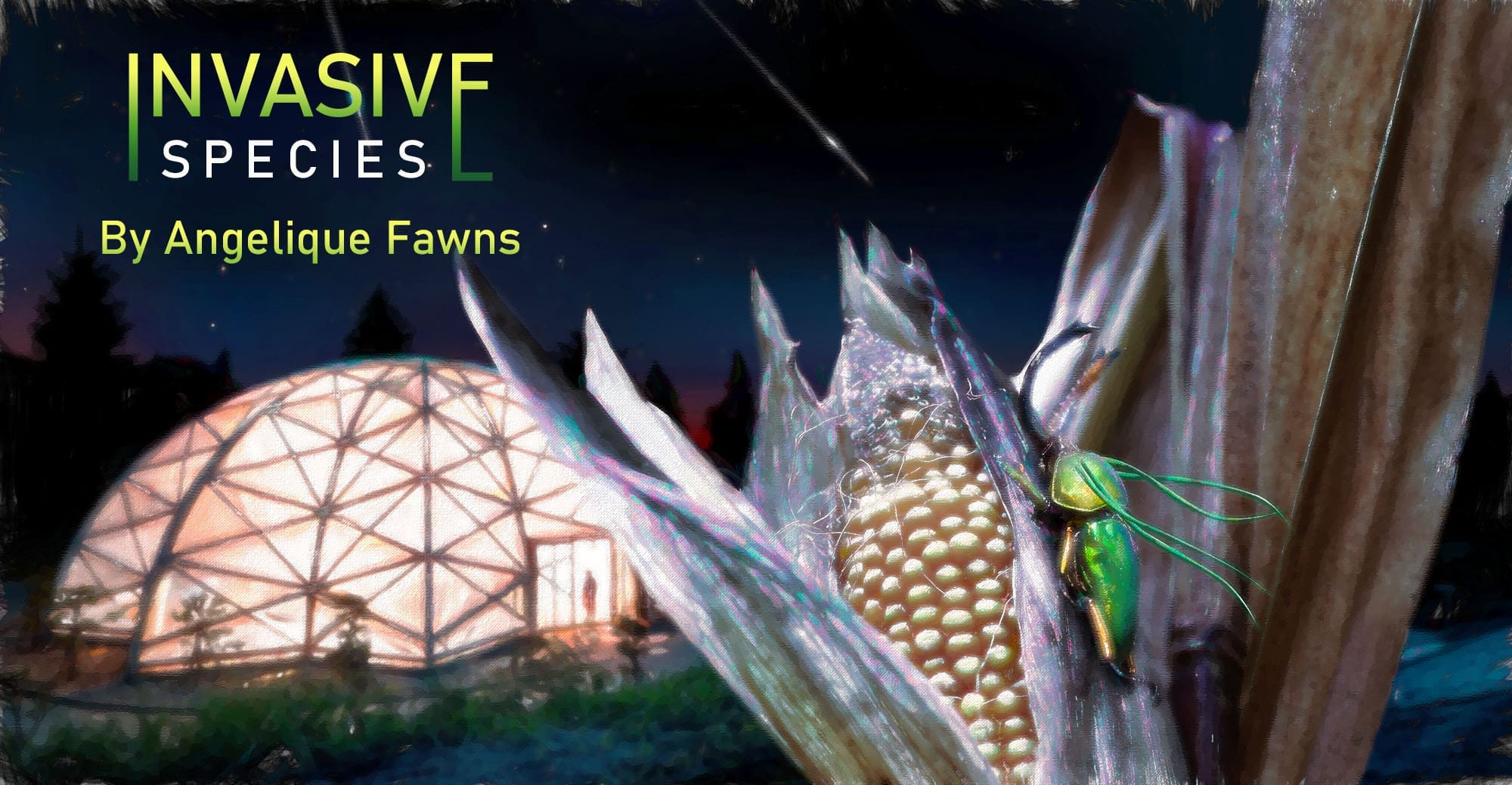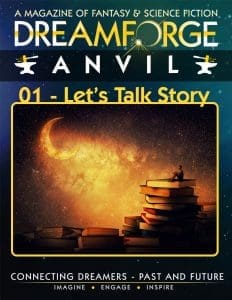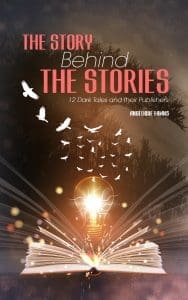WiHM 12: It’s Raining Alien Bugs!

It’s Raining Alien Bugs!
How one horror story found a home.
By Angelique Fawns
We all have dreams. Mine is to explore the darker side of human nature like Shirley Jackson. Create monsters as memorable as Mary Shelley. Learn to show the future with the finesse of Octavia E. Butler.
I started my quest to write horror in 2017. My journey has been riddled with rejection, frustration, and moments where I want to go screaming into the night. It has taken me almost four years to find a home for the very first story I penned. “Invasive Species” is a science fiction/ horror story inspired by climate change and unusual weather patterns. It was rejected 33 times. Rewritten nine times.

In those four years, I’ve also written other short stories, and managed to find homes for approximately 30 of them. But “Invasive Species” was the black albatross around my neck.
Until recently.
 Scot Noel, editor-in-chief of DreamForge Anvil, picked up “Invasive Species” for their pilot issue, “With DreamForge Anvil we not only offer great, positive science fiction and fantasy, we take a behind the scenes look at what the story means to the author and how it reached its final draft.”
Scot Noel, editor-in-chief of DreamForge Anvil, picked up “Invasive Species” for their pilot issue, “With DreamForge Anvil we not only offer great, positive science fiction and fantasy, we take a behind the scenes look at what the story means to the author and how it reached its final draft.”
Noel explains why he chose my alien story, “In “Invasive Species” Angelique presented us with an engagingly written tale constructed around some interesting ideas. I felt the original version could find a home eventually, if it just hit the right editor’s desk at the right time.”
Noel was definitely the right editor. He took me through a series of thoughtful plot revisions and clarifications. (What is the exact science behind growing marijuana? How big of a greenhouse do you need to feed a small family for a year?) The story became 100x better.
Now that I look back on it, the first version created back in 2017 was probably quite horrible, but I was convinced the story had legs. That summer, Toronto was dealing with unprecedented rainfall. I work at a media company down by the lakeshore and EVERYTHING was flooding. The highway was under water in low parts. The sugar factory next door was using sandbags to protect the warehouse floor. People who lived on the Toronto Islands had to move to the main land and were travelling their footpaths by canoe.
To add to the dystopian strangeness of that year, (though 2017 has nothing on 2020) our region’s ash trees were being ravished by an invasive species called the Emerald Ash Borer. My husband works handling these issues for our township, so I knew it was a serious problem. The idea for “Invasive Species” was born. I wrote a 3000-word piece and sent it off to The Magazine of Fantasy and Science Fiction.
C.C. Finlay rejected it, but sent me this note
Thank you for giving me a chance to read “Invasive Species.” I was interested in the premise, but overall, the story didn’t quite grab me — in part, I thought it started in the wrong place or with the wrong event to give it strong narrative momentum — and I’m going to pass. I wish you best of luck finding the right market for it. I appreciate your interest in F&SF and hope that you’ll keep us in mind in the future.”
 I tweaked the story, sent it off to The Writers of the Future Contest, and earned an honorable mention for the second quarter in 2018.
I tweaked the story, sent it off to The Writers of the Future Contest, and earned an honorable mention for the second quarter in 2018.
Then I sent the story off to Abyss & Apex Magazine.
“Thank you for submitting your story to ABYSS & APEX. It was well received here, but after some thought we have decided not to accept it for publication. I hope you’ll consider us again, and I wish you the best success in placing this story elsewhere.”
A year later, I gave the story yet another intensive rewrite, changed the title to “A Flood of Bugs” and resent it to The Magazine of Fantasy and Science Fiction.
“Thank you for giving me a chance to read “A Flood of Bugs.” I don’t remember the earlier version, but this story didn’t quite grab me — I didn’t see what the stakes in the first couple scenes were for Cass and, particularly, Devon, and so the beginning didn’t have a lot of narrative momentum for me. I’m going to pass on this one for Fantasy & Science Fiction, but I wish you best of luck finding the right market for it and hope that you’ll keep us in mind in the future. Also, I’m very happy to see your enthusiasm, especially for revising stories — regardless of how this one turned out, that’s generally the way people become better writers and reach their first sales. Good luck.”
I rewrote it, hoping I was adding “narrative momentum” and sent it to Eerie River Publishing.
“We really enjoyed the tale you wove, the flooding of the Toronto island brought be back to the news reports last year, I think. However, we regret to advise you we will not be using it for our anthology. Although dark in nature, it didn’t quite hit the horror notes we were looking for. It was an interesting take on the call out, but just not for us.”
In 2019, I submitted it to Unreal Magazine and though it received a “blue ribbon” for being on the right track, it wasn’t purchased.
So, I sent it on to The Reckoning.
“Thank you very much for submitting “Invasive Species” to Reckoning, but unfortunately it isn’t what we’re looking for right now. The concept, while clever, is somewhat overdone — we see a lot of aliens-as-invasives go by. Best of luck in placing this elsewhere.”
I rewrote it. Again. And found an open call at The Rabbit Hole.
“Many thanks for sending us your story for consideration in The Rabbit Hole. However, with 114 submissions in contention, I’m afraid we feel unable to include it. It’s an interesting piece, with an intriguing concept at its core. Unfortunately, though, we felt that it would have needed a different treatment to make a stronger impact. Such judgments are subjective, of course, so you may find that others will differ, and I wish you all success in placing it elsewhere.”
If a magazine actually offers commentary it usually means they liked your work. I was getting lots of comments but no contracts. Time for another rewrite, and off to Visions Magazine.
“We’ve reviewed “Invasive Species” and unfortunately it hasn’t made the cut. It’s a nice pitch that creates an interesting atmosphere, unfortunately the story doesn’t fit with the rest of the commissioned pieces. Overall, the delivery didn’t feel fully mastered and the narrative could have been snappier. It left me wanting something a bit more crafted to create a more long-lasting impression.”
It was sheer luck I found Scot Noel and DreamForge Anvil. I had sent several stories his way over the years, but none of them were picked up. (Even though I always appreciated the thoughtful rejection letters.)
 I’ve recently published an anthology called The Story Behind the Stories: 12 Dark Tales and their Publishers. It showcases my previously published tales, interviews from the purchasing editors, plus all the rejection letters each piece got before pick-up.
I’ve recently published an anthology called The Story Behind the Stories: 12 Dark Tales and their Publishers. It showcases my previously published tales, interviews from the purchasing editors, plus all the rejection letters each piece got before pick-up.
Scot Noel not only gave me permission to use his helpful advice, but asked me to participate in the DreamForge Anvil project if I could send him a worthy story.
I sent him four stories that I couldn’t find a home for. He picked “Invasive Species”. You can read the whole story for free at DreamForge Anvil, and have the option to buy an affordable subscription to see all the line-edits.
I may not have managed to write “The Lottery”, “Frankenstein”, or “Kindred” yet, but I do feel with help from editors like Scot Noel, I might be getting a tiny bit closer.
- About the Author
- Latest Posts
Angelique Fawns writes horror, fantasy, kids short stories, and freelance journalism. Her day job is producing promos and after hours she takes care of her farm full of goats, horses, chickens, and her family. She has no idea how she finds time to write. She currently has stories in Ellery Queen, DreamForge Anvil, and Third Flatiron’s Gotta Wear Eclipse Glasses. You can follow her work and get writing tips and submission hints at http://fawns.ca/.












